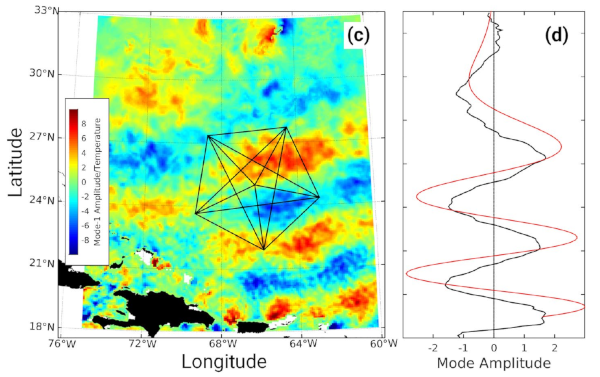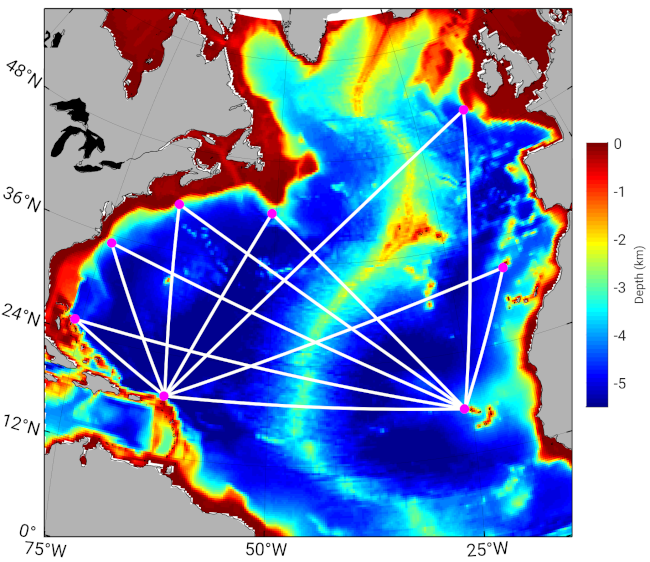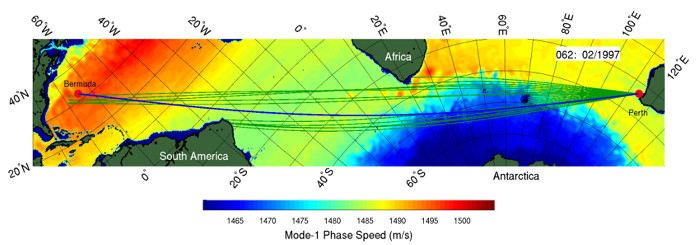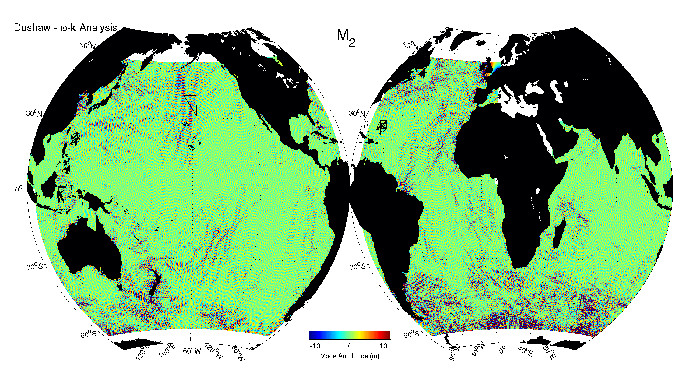|
I was an oceanographer at the
Applied Physics Laboratory, University of Washington from 1992-2016,
and an an affiliate assistant/associate professor of Oceanography at the
School of Oceanography,
UW from 1999—2015. From 2015—2018, I was a research scientist at
the Nansen Center in Bergen, Norway.
My interests were in the application of long-range acoustic transmissions for ocean
observation - also known as ocean acoustic tomography. An essential aspect of tomography is to
understand the acoustic forward problem, so a closely related interest is to understand the
nature of long-range acoustic propagation in the ocean.
Tomography is a technique that has matured; it
offers excellent signal-to-noise capability for observing variability at the largest oceanic scales. Three
applications I pursued were: measuring the large-scale variations of heat content in
ocean basins, estimation of the radiation of low-mode internal tides from topographic features and the
apparent predictability of that radiation in the ordinary tidal sense, and measuring the heat and heat transport
through Fram Strait to high precision. Other interests were modeling and data assimilation (and how tomography
may be used in models), and the effective use of parallel computational techniques (SMP machines, cluster of PCs,
graphics cards/CUDA) in scientific analysis.
|
Archives/Downloads (Zenodo.org)
I've recently been using zenodo.org as an archiving site. This is a free
service provided for scientific archives by CERN. They guarantee that Zenodo will be around so long as CERN
is around. Gray literature, data, software, etc. can be archived for easy access and download, and a reliable
citation with a DOI is automatically provided. What a deal!
- ECCO Iter22 Global Ocean State Estimate - 1 January 2004 to 30 April 2005: Global values of ocean
temperature, salinity, and sound speed derived from state estimates from the MIT-JPL-SIO ECCO program in 2010. The
state estimate name is "Iter22" with global values at 1/4 degree resolution and 33 depths in the vertical. Data
are stored as netcdf 4 files of total size 13.4 GB. The original purpose of the sound speed estimates was to
simulate long-range acoustic propagation in a realistic oceanic environment. Files are 3-day averages estimating
the actual oceanic state from the period 1 January 2004 to 30 April 2005.
Citation: Dushaw, B. D. (2024). ECCO Iter22 Global Ocean State Estimate - 1 January 2004 to 30 April 2005 (1.0)
[Data set]. Zenodo.
https://doi.org/10.5281/zenodo.13707843
- Ocean acoustic tomography and scientific disagreement. An essay on the
scientific integrity, or lack thereof, of opposition to oceanic measurement
by tomography.
Citation: Dushaw, B. (2024). Ocean acoustic tomography, physical oceanographers, and scientific disagreement: An essay. Zenodo. https://doi.org/10.5281/zenodo.11544629
- EIGENRAY: Computer code in FORTRAN for computing ocean acoustic propagation by ray tracing. This code
was developed beginning about 1998 and extending over many years. Version 3.5.
Citation: Dushaw, B. D. (2024). EIGENRAY: FORTRAN computer code for computing long-range, deep-ocean acoustic
propagation by ray tracing (Version 3.5). Zenodo.
https://doi.org/10.5281/zenodo.10816780
- MPIRAM: M. D. Collins' Range-dependent Acoustic Model (RAM) for long-range oceanic acoustic propagation
coded in FORTRAN 95 and parallelized for OpenMP or Message Passing Interface (MPI). Version 2024.
Citation: Dushaw, B. D. (2024). MPIRAM: M. D. Collins' Range-dependent Acoustic Model (RAM) for long-range
oceanic acoustic propagation coded in FORTRAN 95 and parallelized for OpenMP or Message Passing Interface
(MPI) (Version 2024). Zenodo.
https://doi.org/10.5281/zenodo.10818570
- Acoustic.Ocean: Some time ago I developed this software package using Matlab to bring
together mapping, environmental data, sea floor topography, and acoustic computation code to allow
easy computation of acoustic properties along geodesic paths, among other tasks. The package proved
to be popular, but it is so large I have not been able to host it here locally for easy download. As
a bonus, in this package the World Ocean Atlas and sea floor topography data have been updated to
2023. Freely provided with no guarantee or support.
Citation: Dushaw, Brian D. (2023). Acoustic.Ocean: A graphical user interface (Matlab) for selecting
geodesic paths across the global oceans, extracting oceanographic properties (sound speed, temperature),
and computing expected acoustic propagation properties (Version 2023). Zenodo.
https://doi.org/10.5281/zenodo.8286625.
- Dushaw, B. D. (2017) Estimating temperature in Fram Strait using DAMOCLES and ACOBAR
acoustic tomography data by exploiting small-scale variability, NERSC Technical Report 378,
Nansen Environmental and Remote Sensing Center, Bergen, Norway, 6 November 2017, 43 pp. Zenodo.
https://doi.org/10.5281/zenodo.7432201.
|
Tidal Data/Downloads (Zenodo.org)
Internal tides have become an acceptable, if not hot, topic these days, but still people have
yet to take advantage of the in situ tomography time series that started this mini revolution. Perhaps
providing these data for ready access will motivate greater usage. Barotropic tide modelers go to great
lengths to use in situ tide guage data for testing, etc., but baroclinic tide modelers have yet to use
these high-quality in situ data, go figure. It's been 30 years. All the data available for download
below are in the form of small (less than 200 kB), standard netcdf files.
AMODE: Time series of baroclinic mode-1 amplitude and barotropic current derived from the
1991-2 Acoustic Mid-Ocean Dynamics Experiment (AMODE) tomography data in the North Atlantic.
- Citation: Dushaw, B. D. (2022). Acoustic Mid-Ocean Dynamics Experiment (AMODE), 1991, North Atlantic:
High-frequency Baroclinic Mode-1 Amplitudes (1.0) [Data set]. Zenodo.
https://doi.org/10.5281/zenodo.6662719.
- Time series of barotropic barotropic current derived from the 1991-2 AMODE tomography data. These data
are a precise measure of path- and depth-averaged current, dominated by the barotropic tides.
Citation: Dushaw, B. D. (2022). Acoustic Mid-Ocean Dynamics Experiment (AMODE), 1991, North Atlantic:
High-frequency Barotropic Currents (1.0) [Data set]. Zenodo. https://doi.org/10.5281/zenodo.6659034
HOME: Ocean acoustic tomography was used to measure tides in the farfield of the Hawaiian Ridge
in 2001 during the Hawaiian Ocean Mixing Experiment (HOME). The measurements were components
of a suite of large- and small-scale measurements obtained during HOME with the aim of
illuminating the pathways of tidal energy that may be driving deep-ocean mixing. Using
reciprocal transmissions, the tomographic arrays were designed to measure the radiation
of mode-1 internal tides from the Ridge, together with barotropic tidal currents. These
publications make available the tomographic estimates for barotropic currents and mode-1
internal-waves derived from the six paths of the northern and southern HOME tomography arrays.
- Citation: Dushaw, B. D., (2024). The 2001 Hawaiian Ocean Mixing Experiment (HOME):
Mode-1 Internal-tide Amplitude Data from the Northern Tomographic Array. Zenodo.org,
https://doi.org/10.5281/zenodo.12590033.
- Citation: Dushaw, B. D., (2024). The 2001 Hawaiian Ocean Mixing Experiment (HOME):
Mode-1 Internal-tide Amplitude Data from the Southern Tomographic Array. Zenodo.org,
https://doi.org/10.5281/zenodo.12590217.
- Citation: Dushaw, B. D., (2024). The 2001 Hawaiian Ocean Mixing Experiment (HOME):
High-frequency (>1cpd) Barotropic Current Data from the Northern Tomographic Array.
Zenodo.org,
https://doi.org/10.5281/zenodo.12590519.
- Citation: Dushaw, B. D., (2024). The 2001 Hawaiian Ocean Mixing Experiment (HOME):
High-frequency (>1cpd) Barotropic Current Data from the Southern Tomographic Array.
Zenodo.org,
https://doi.org/10.5281/zenodo.12590584.
|
RESEARCH HIGHLIGHTS
Revisiting "Resonant Diurnal Internal Tides in the North Atlantic"!
In 1998, we published "Resonant Diurnal Internal Tides in the North Atlantic" in Geophysical Research Letters
direct link. The paper showed how the diurnal internal tide
variations observed by tomography in the Sargasso Sea were standing internal waves, trapped between Puerto Rico
and the 30N turning latitude for diurnal frequencies. The paper had a simple 1-D standing wave model, and I've
wondered what the waves would look like realistically.
Fast forward 25 years, and there now exist global ocean models of high enough resolution that
they have begun to include the internal tides. I thought perhaps such a model would pick up the diurnal internal
tides observed by the AMODE tomography array in the early 1990s. The results were spectacular, really. The
global simulations are not perfect, but they certainly are well on their way to accurate representations of
internal tides. As I have been saying for 30 years, the tomography observations of both barotropic and baroclinic
tides are clear, unprecedented measurements, offering an excellent benchmark for ocean models. The paper is
available as open access (be sure to take a look at the Supplementary animations; needless to say, the 1998 paper
is a prerequisite to reading this paper):
Dushaw, B. D., & Menemenlis, D. (2023). Resonant diurnal internal tides in the North Atlantic: 2. Modeling.
Geophysical Research Letters, 50, e2022GL101193. DOI: https://doi.org/10.1029/2022GL101193
direct link
to the article.

Review Paper
A review paper on the contributions of acoustic tomography to physical oceanography, with citation:
Dushaw, B.D., 2022. Surprises in Physical Oceanography: Contributions from Ocean Acoustic Tomography.
Tellus A: Dynamic Meteorology and Oceanography, 74, 33–67. DOI: http://doi.org/10.16993/tellusa.39
A direct link to the article which is open access.
I provide an essay on scientific disagreement in conjunction with this paper:
Acoustic tomography, physical oceanographers, and scientific disagreement: An essay. I view the essay of general interest
for scientists who need to know the nature of argument, disagreement, and the variety
of rhetorical tricks one's peers may employ to dispute ideas. I only learned of
"ad hominem", "ipse dixit", and "straw man" arguments, all fallacious, rather late in
life.
By way of historical record, I provide here a manuscript entitled "Towards Global Predictions of the Mode-1 Internal Tide", submitted
to Geophysical Research Letters in June 2011, and promptly rejected. I don't recall any substantive argument critical of
the manuscript. I got the impression that the single reviewer and editor just did not believe the result, with the
reviewer explicitly disregarding the paper just published in Deep-Sea Research, "On the Predictability of Mode-1 Internal
Tides." It has taken physical oceanographers quite some time to accept to the idea. Here, a dozen years later in 2023 as I
write this, the topic has, of course, become hot (see below for the global predictions).
Dushaw, B. D., 2011, Towards Global Predictions of the Mode-1 Internal Tide,
Geophysical Research Letters, rejected.
Ocean Acoustic Tomography in the North Atlantic
Deployments of acoustic tomography systems in the North Atlantic have been discussed for many years
as a contribution to the global ocean observing system. This new analysis, employing a state
estimate for the North Atlantic and a simplistic objective mapping approach, suggests that the
combination of tomography with the Argo float system could approximately halve the present
measurement uncertainties for the large-scale temperature properties of the North Atlantic. Acoustic
tomography and Argo float measurements are complementary.
Dushaw, B., 2019. Ocean acoustic tomography in the North Atlantic, J. Atmos. Ocean. Tech., 36,
183–202. doi: 10.1175/JTECH-D-18-0082.1 Article

Sea floor topography and notional tomography paths spanning the North Atlantic. This array
consists of 2 acoustic sources and 7 hydrophone arrays. Azimuthal equal area projection.
Recent Tomography Advocacy/Conference Papers (2016-2017)
-
Dushaw, B., 2016. Ocean acoustic tomography: A missing element of the ocean observing system, in Proceedings Institute
of Acoustics, Conference, Acoustic & Environmental Variability, Fluctuations and Coherence, Cambridge, U.K., 12-13
December 2016, 5 pp. Article
-
Dushaw, B., J. Colosi, T. Duda, M. Dzieciuch, B. Howe, A. Kaneko, H. Sagen, E. Skarsoulis, and X. Zhu, 2017. Ocean acoustic
tomography: A missing contribution to the Ocean Observing System, in Proceedings Underwater Acoustics Conference and
Exhibition 2017, Skiathos Island, Greece, 3-8 September 2017, 12 pp. Article
-
Dushaw, B., 2017. Acoustic tomography as a component the Atlantic Ocean Observing System: Opportunities and Challenges, in
Proceedings 8th EuroGOOS Conference, Bergen, Norway, 3-5 October 2017, 5 pp.
Article
-
Dushaw, B., 2017. Ocean Observing Systems and Ocean Observatories, Oceanographers and Acousticians - A Personal Perspective,
in Applied Underwater Acoustics, L. Bjørnø (T. Neighbors, D. Bradley, Eds.) Amsterdam, Netherlands:
Elsevier, 964 pp., ISBN: 978-0-12-811240-3, pp. 931–934.
Article
|
The Fram Strait Papers (2016-2017)
-
Dushaw, B. D., H. Sagen and A. Beszczynska-Möller, 2016. Sound speed as a proxy variable to
temperature in Fram Strait, J. Acoust. Soc. Am., 140, 622–630. doi: 10.1121/1.4959000
-
Dushaw, B. D., and H. Sagen, 2016. A comparative study of moored/point and acoustic tomography/integral observations of sound speed in Fram Strait using objective mapping techniques, J.
Atmos. Oceanic Tech., 33, 2079–2093. doi: 10.1175/JTECH-D-15-0251.1
-
Dushaw, B. D., H. Sagen, and A. Beszczynska-Möller, 2016. On the effects of small-scale variability on acoustic propagation in Fram Strait: The tomography forward problem, J. Acoust.
Soc. Am., 140, 1286–1299. doi: 10.1121/1.4961207
-
Sagen, H., B. D. Dushaw, E. K. Skarsoulis, D. Dumont, M. A. Dzieciuch, and A.
Beszczynska-Möller, 2016. Time series of temperature in Fram Strait determined
from the 2008-2009 DAMOCLES acoustic tomography measurements and an ocean
model, J. Geophys. Res., 121, 4601–4617. doi: 10.1002/2015JC011591
-
Sagen, H., F. Geyer, S. Sandven, M. Babiker, B. D. Dushaw, P. F. Worcester, M. A. Dzieciuch, B. Cornuelle, A. Beszczynska-Möller, 2017. Resolution, identification, and stability of broadband acoustic arrivals in Fram Strait, J. Acoust. Soc. Am., 141, 2055–2068, doi: 10.1121/1.4978780
-
Dushaw, B. D., and H. Sagen, 2017. The role of simulated small-scale ocean variability in inverse
computations for ocean acoustic tomography, J. Acoust. Soc. Am., 142, 3541–3552.
doi: 10.1121/1.5016816
|
Encyclopedia Article. An encyclopedia article on ocean
acoustic tomography. The citation is:
Dushaw, B. D.,
2014. ‘‘Ocean Acoustic Tomography’’
in Encyclopedia of Remote Sensing, E. G. Njoku, Ed.,
Springer, Springer-Verlag Berlin Heidelberg, 939 p., pp. 4–11. doi: 10.1007/SpringerReference_331410
Acoustic Reverberation From an Atomic Test. I took another look at the acoustic signals generated by the 1955 atomic test "WIGWAM"
in the eastern North Pacific. The sound pulse illuminated the entire North and South Pacific
basins and was reflected back to California and Hawaii to be recorded as hours-long coda. A quite
simple analysis produced this paper with
the citation:
Dushaw, B. D.,
2015. WIGWAM reverberation revisited, Bulletin
Seismological Soc. Am., 105, 2242–2249.
doi: 10.1785/0120150024
The electronic supplemenatary material for the paper can be seen on the BSSA website, or on this
website HERE.
I presented these results at the UACE2017 conference. The conference paper gives a discussion
on why and how I came to work on this problem:
Dushaw, B., 2017. WIGWAM Reverberation Revisited, in Proceedings Underwater Acoustics Conference and Exhibition 2017,
Skiathos Island, Greece, 3-8 September 2017, 5 pp. Article
Antipodal Acoustic Thermometry. The culmination of quite a
lot of numerical and historical research, we used
acoustic signals from an antipodal acoustic propagation experiment in 1960 to
make an estimate of the change in ocean temperature from 1960 to 2004, averaged
along the sound channel axis. The signals traveled from Perth, Australia to
Bermuda. The measurements in 1960 were established to have
a meaningful accuracy, and equivalent signals were computed using numerical
ocean state estimates for 2004. No change in travel time (hence no change in
temperature from 1960 to 2004) was observed. While error bars were large, they
were not particularly larger than other measurement types. The computation
establishes acoustic thermometry as both a viable and important measurement
type, complementary to other measurement types. The
lengthy publication is open access.
Dushaw, B. D., and D. Menemenlis,
2014. Antipodal acoustic thermometry: 1960, 2004,
Deep-Sea Res. I,
86, 1–20. doi: 10.1016/j.dsr.2013.12.008
Dushaw, B. D., 2008. Another look
at the 1960 Perth to Bermuda long-range acoustic propagation experiment,
Geophys. Res. Lett., 35. doi: 10.1029/2008GL033415

Global Predictability of Mode-1 Internal Tides. This year (2015) marks the 20th anniversary
of a paper published in 1995 reporting on the radiation of mode-1 internal tides from Hawaii far into the ocean's
interior as measured by acoustic tomography. This radiation was confirmed a year later by observations by the
TOPEX/POSEIDON satelite altimeter. I have worked on these observations, on and off, over this 20 year period. This
work eventually led to the conclusion that these internal tide waves are so coherent that their amplitude and
phase are in fact predictable, much like the barotropic tide. A detailed and thorough analysis of both
tomography and satelite altimetry data demonstrating this predictability appeared in a
publication in the journal Deep-Sea Research
in 2011. While the practical value of this discovery is to be determined, the discovery is somewhat revolutionary
in that it overturns firmly held views by physical oceanographers about the incoherence of ocean variability.
With support from the National Aeronautics and Space Administration, his work has
been extended and refined to develop a global model that can be used to predict
the tidal amplitude and
phase of mode-1 internal tides anywhere in the world's oceans. The model predicts the in situ observations by
acoustic tomography from the Philippine to Sargasso Seas. The animation below gives the mode-1 internal tide
amplitude for the M2 frequency; the model includes the six major tidal constituents and modes 1
and 2.
The 114 pp. report describing this model can be accessed
HERE (v1.1) (19 MB). The use of acoustic
tomography and satelite altimetry illustrates the complementary nature of these data types – altimetry
shows the spatial coherence of these internal tides, while tomography shows the temporal coherence.
(NEW - 11/10/2015) This model, together with software and documentation to enable computation of tidal predictions
or plotting of maps, can be downloaded from HERE (APL
site - See Supplemental Materials. A tarball of 2.4 GB in size contains the model and other aspects of the solution.) Unpacking this tarball
gives the empirical model and associated software that can be used for predicting mode-1 internal tides.
The tarball also disseminates the tomography and thermistor observations (time series of mode-1 amplitude derived
using acoustic tomography or thermistor data), animations of mode-1 internal tides the world over, and mode-1
properties derived from climatology that allow the mode-1 solutions for SSH to be extended into the ocean's
interior (mode amplitude, current, displacement, etc.).
The citations for the 2011 publication and this Technical Memorandum are:
Dushaw, B. D., P. F. Worcester, and
M. A. Dzieciuch, 2011. On the predictability of mode-1 internal tides,
Deep-Sea Res. I, 58, 677–698. doi: 10.1016/j.dsr.2011.04.002
Dushaw, B., 2015. An Empirical Model for Mode-1 Internal Tides Derived from Satellite
Altimetry: Computing Accurate Tidal Predictions at Arbitrary Points over
the World Oceans, Technical Memorandum APL-UW TM 1-15, 114 pp.

|
Click on the image to view a large-scale animation of M2 mode-1
amplitude (not SSH) (27 MB).
Brian Dushaw
email: dushaw-at-uw.edu
|

|






